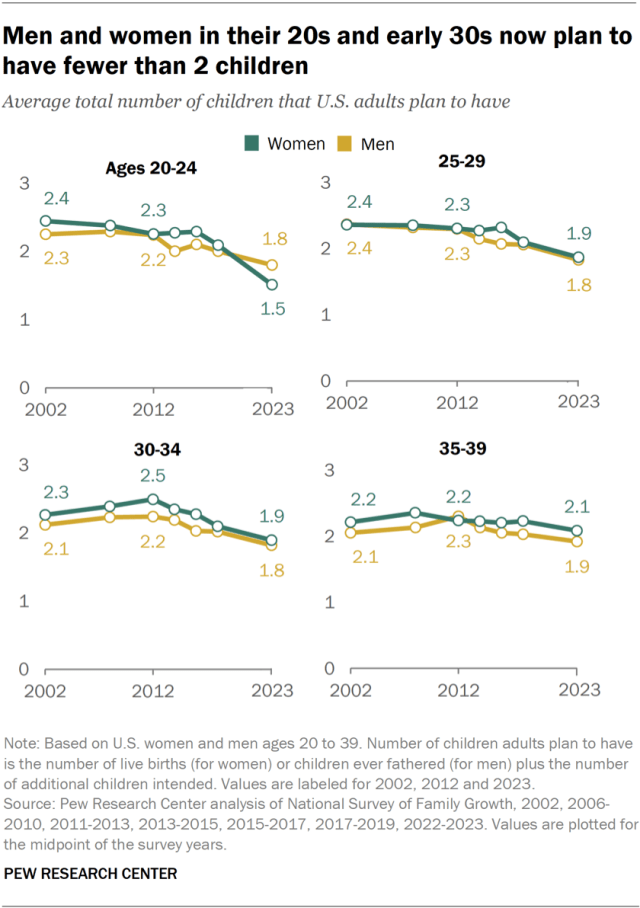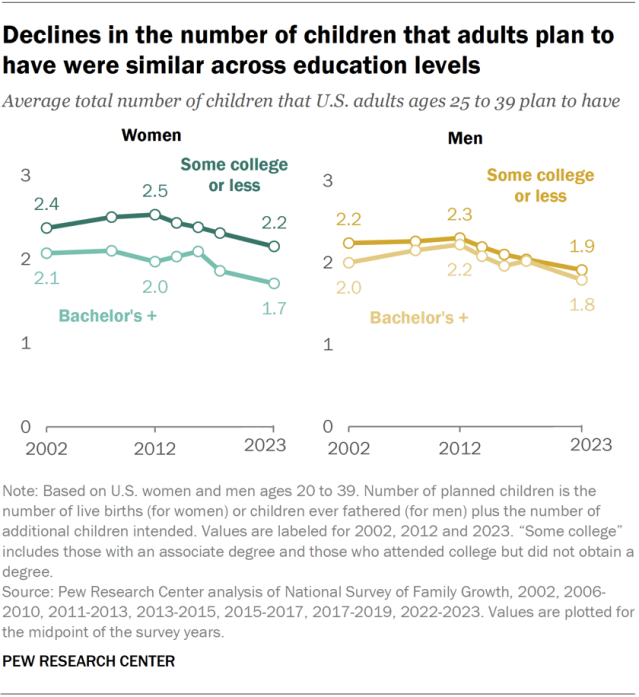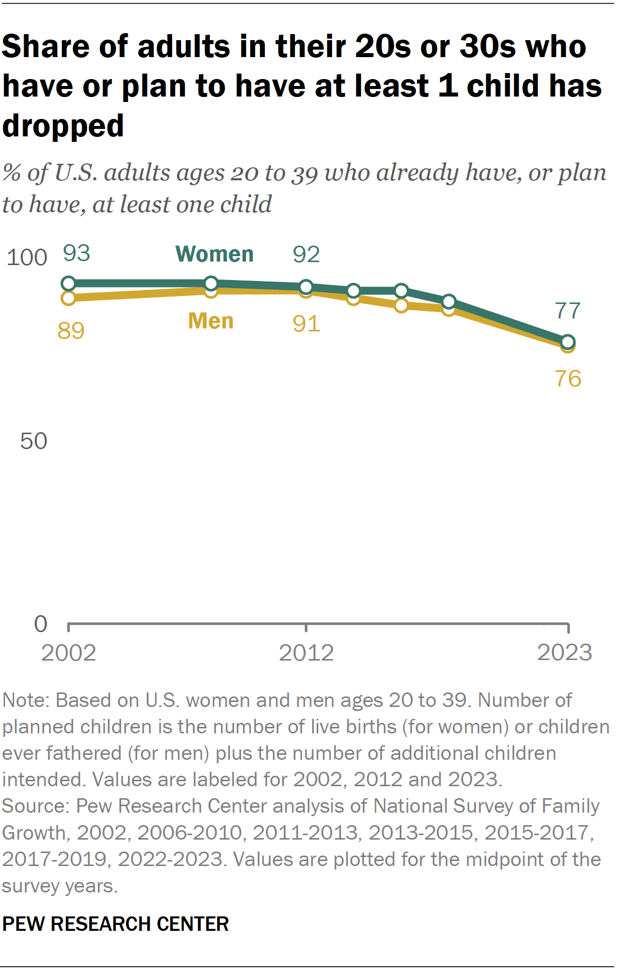Americans in their 20s and 30s are planning to have fewer children than a decade ago, according to a Pew Research Center analysis of government data. The total number of children that women and men ages 20 to 39 planned to have, on average, dropped from 2.3 in 2012 to 1.8 in 2023. Those numbers remained stable from 2002 to 2012.

The total number of children that adults plan to have is the number of children they already have plus the number of (additional) children they intend to have. (For details on how this was calculated, refer to “How we did this.”)
We conducted this analysis amid national discussions about low birthrates in the United States. The White House has been considering proposals to encourage women to have more children. And the pronatalism movement, whose mission is to increase the U.S. birthrate, has received a lot of media attention in the past few months.
In 2023, the total number of children that men and women ages 20 to 39 planned to have fell below 2.1. This is important because 2.1 is about the average number of children, per woman, that a population needs to replace itself over time.
Related: The Experiences of U.S. Adults Who Don’t Have Children

These declines in the number of children adults plan to have occurred almost entirely in the last decade. They also played out somewhat differently by age and by gender.
Between 2012 and 2023, the total number of children that women planned to have, on average, dropped from:
- 2.3 to 1.5 for women ages 20 to 24
- 2.3 to 1.9 for women ages 25 to 29
- 2.5 to 1.9 for women ages 30 to 34
There was not a significant drop for women ages 35 to 39. Among men, the declines were similar across all age groups.
In most age groups, the total number of children that men and women planned to have fell below 2.1 in 2023. (The exception was among women ages 35 to 39.)
How well do plans predict the future?
Intentions do not always predict what is going to happen. However, the data allows us to look at what happens as adults age.
For example, in 2002, women ages 20 to 24 had or planned to have 2.4 children on average. Then, in 2012, women 30 to 34 – who had aged 10 years since 2002 – had or planned to have 2.5 children on average.
However, once women in this group had mostly completed fertility – that is, ages 40 to 44 in 2023 – they had given birth to 1.9 children on average. (Note that this dataset did not interview the same women over time, so these numbers come from different women in each survey wave.)
Looking at the data this way, we see that plans for childbearing remain relatively stable for adults from their early 20s to their early 30s. But by the time they near the end of their fertility years, they tend to have fewer children than they had planned.
Differences by education
Women with a four-year college degree plan to have fewer children than women without a four-year degree. In 2023, the total number of children that women ages 25 to 39 planned to have was:

- 1.7 among those with a college degree
- 2.2 among those without a college degree
There were not significant differences by education among men. (This part of the analysis focuses on adults ages 25 to 39 rather than 20 to 39 because this group has mostly completed their education.)
There were similar drops between 2002 and 2023 in the number of children that women ages 25 to 39 with and without a bachelor’s degree planned to have. The same was true for men ages 25 to 39.
But among women ages 30 to 34, the decline occurred almost entirely among those with a bachelor’s degree:
- In 2023, women ages 30 to 34 with at least a bachelor’s planned to have 1.5 children, down from 2.1 in 2002.
- Among women ages 30 to 34 without a bachelor’s, the number of planned children was virtually unchanged.
Shares of adults who have or plan to have at least one child

Not only did the average number of children people plan to have fall, but so did the share of adults in their 20s and 30s who already have or plan to have at least one child.
In 2023, about three-quarters of men (76%) and women (77%) had or planned to have at least one child. This was down from about nine-in-ten in 2012.
This drop was particularly notable among women ages 20 to 24. In 2023, 66% of this group had or planned to have at least one child, compared with 93% in 2012 and 94% in 2002.
Declines were smaller for men ages 20 to 24 – falling from 89% in 2012 to 75% in 2023 – and for women and men in other age groups.
What do Americans say about fewer people choosing to have children?
In 2024, we asked Americans about the impact on the country of fewer people choosing to have children. We also asked how effective they thought certain federal policies would be at encouraging more people to have children in the future.
Almost half of U.S. adults (47%) said fewer people choosing to have children would have a negative impact on the country, while 20% said it would have a positive impact. Another 31% said it would have neither a positive nor a negative impact.
When it comes to federal policies, 60% of adults said providing free child care would be extremely or very effective in encouraging more people to have children. Roughly half said the same about requiring employers to provide paid family leave (51%) and providing more tax credits for parents (49%). And 45% said giving parents of minor children a monthly payment would be highly effective.